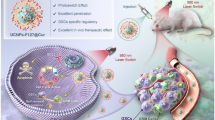Abstract
Purpose: Given that p53 is a tumor suppressor that plays a central role in the cellular response to DNA damage and that more than 50% of all cancers have mutated p53, the wider utility of photodynamic therapy (PDT) in the treatment of cancer will depend on an understanding of whether p53 status modulates response to PDT. In this study, we investigated the photosensitivity of isogenic cell lines that differ only in their p53 status to PDT using hypericin as the photosensitizer. Methods: Acute (MTT) and chronic (clonogenic) cytotoxic assays were performed on two osteosarcoma cell-lines (U2OS and U2OS+p53DD) that are isogenic except that the latter expresses dominant negative p53. The inducible expression of p53 was determined on western blots. Uptake of hypericin, cell cycle profile analysis, measurement of membrane phosphatidylserine externalization and changes in mitochondrial membrane potential were investigated using flow cytometry. Results: Hypericin uptake was observed to be equivalent in U2OS and U2OS+p53DD cells. There were no significant differences in cell killing between these cell-lines in both the MTT and clonogenic assays (IC50 of 0.4 μg/ml from MTT assay). p53 expression did not increase up to 24 h after PDT treatment in both cell lines. There were also no significant differences in the cell-cycle arrest profiles and timing of onset of apoptosis. Conclusions: Taken together, these results suggest that the status of p53 may not be important in PDT-mediated cell killing or induction of apoptosis. By extension, these results imply that PDT may be used with equal efficacy for the treatment of p53-positive and -negative tumors.







Similar content being viewed by others
References
Dolmans DE, Fukumura D, Jain RK (2003) Photodynamic therapy for cancer. Nat Rev Cancer 3:380–387
Mates JM, Sanchez-Jimenez FM (2000) Role of reactive oxygen species in apoptosis: implications for cancer therapy. Int J Biochem Cell Biol 32:157–170
Enoch T, Norbury C (1995) Cellular responses to DNA damage: cell-cycle checkpoints, apoptosis and the roles of p53 and ATM. Trends Biochem Sci 20:426–430
Tsang NM, Nagasawa H, Li C, Little JB (1995) Abrogation of p53 function by transfection of HPV16 E6 gene enhances the resistance of human diploid fibroblasts to ionizing radiation. Oncogene 10:2403–2408
Fan S, Smith ML, Rivet DJ 2nd, Duba D, Zhan Q, Kohn KW, Fornace AJ Jr, O’Connor PM (1995) Disruption of p53 function sensitizes breast cancer MCF-7 cells to cisplatin and pentoxifylline. Cancer Res 55:1649–1654
Fisher AM, Rucker N, Wong S, Gomer CJ (1998) Differential photosensitivity in wild-type and mutant p53 human colon carcinoma cell lines. J Photochem Photobiol B 42:104–107
Zhang WG, Li XW, Ma LP, Wang SW, Yang HY, Zhang ZY (1999) Wild-type p53 protein potentiates phototoxicity of 2-BA-2-DMHA in HT29 cells expressing endogenous mutant p53. Cancer Lett 138:189–195
Yang HY, Zhang WG, Ma LP, Wang SW (2001) An approach to enhancing the phototoxicity of a novel hypocrellin congener to MGC803 cells. Dyes Pigment 51:103–110
Fisher AM, Ferrario A, Rucker N, Zhang S, Gomer CJ (1999) Photodynamic therapy sensitivity is not altered in human tumor cells after abrogation of p53 function. Cancer Res 59:331–335
Heinzelmann-Schwarz V, Fedier A, Honung R, Walt H, Haller U, Fink D (2003) Role of p53 and ATM in photodynamic therapy-induced apoptosis. Lasers Surg Med 33:182–189
Bowman T, Symonds H, Gu L, Yin C, Oren M, Van Dyke T (1996) Tissue-specific inactivation of p53 tumor suppression in the mouse. Genes Dev 10:826–835
Agostinis P, Vantieghem A, Merlevede W, de Witte PA (2002) Hypericin in cancer treatment: more light on the way. Int J Biochem Cell Biol 34:221–241
Tong Z, Singh G, Rainbow AJ (2000) The role of the p53 tumor suppressor in the response of human cells to photofrin-mediated photodynamic therapy. Photochem Photobiol 71:201–210
Xue LY, Chiu SM, Oleinick NL (2001) Photodynamic therapy-induced death of MCF-7 human breast cancer cells: a role for caspase-3 in the late steps of apoptosis but not for the critical lethal event. Exp Cell Res 263:145–155
Ali SM, Olivo M (2002) Bio-distribution and subcellular localization of hypericin and its role in PDT induced apoptosis in cancer cells. Int J Oncol 21:531–540
Ali SM, Olivo M (2003) Mechanisms of action of phenanthroperylenequinones in photodynamic therapy (review). Int J Oncol 22:1181–1191
Brown SM, Wouters BG (1999) Apoptosis, p53, and tumor cell sensitivity to anticancer agents. Cancer Res 59:1391
Dougherty TJ, Gomer CJ, Henderson BW, Jori G, Kessel D, Korbelik M, Moan J, Peng Q (1998) Photodynamic therapy. J Natl Cancer Inst 90:889
Acknowledgements
We thank Kenneth Raj for the gift of U2OS and U2OS+p53DD cell-lines and the sponsors of CARIF for supporting this work. CARIF is a non-profit research organization committed to an understanding of cancer prevention, diagnosis and treatment through a fundamental research program.
Author information
Authors and Affiliations
Corresponding author
Rights and permissions
About this article
Cite this article
Lee, H.B., Ho, A.S.H. & Teo, S.H. p53 Status does not affect photodynamic cell killing induced by hypericin. Cancer Chemother Pharmacol 58, 91–98 (2006). https://doi.org/10.1007/s00280-005-0131-3
Received:
Accepted:
Published:
Issue Date:
DOI: https://doi.org/10.1007/s00280-005-0131-3




